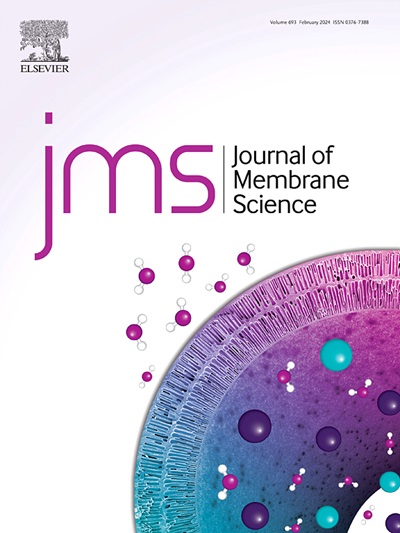Interchain regulation actuated bifunctional conjugated polymer membrane for efficient precious metal recovery from water
IF 8.4
1区 工程技术
Q1 ENGINEERING, CHEMICAL
引用次数: 0
Abstract
Membrane technology plays a vital role in mitigating the risk of supply disruptions due to the scarcity of precious metals critical for various applications. However, the trade-off between permeability and rejection of membranes is limited by structural constraints within aggregation domains and inherent performance inefficiencies. Herein, we proposed an interchain modulation strategy in reductive conjugated polymer membranes to enhance precious metal recovery from water. The introduction of charge-rich mediators utilized the π-electron dispersion effect to adjust the overall order of the molecules, which served as sub-nano channels to accelerate water transport and electron transfer in the membranes. These mechanisms synergistically enabled state-of-the-art Ag(I) reduction rate (96.9 %), with more than doubled increase in flux and interception simultaneously, thereby achieving exceptional silver selectivity from wastewater generated by strategic emerging industries. Our results offer a versatile design blueprint for developing reductive bifunctional membranes, promoting the sustainable utilization of precious metals.

链间调控驱动双功能共轭聚合物膜高效回收水中贵金属
膜技术在减轻供应中断的风险方面起着至关重要的作用,因为贵金属的稀缺是各种应用的关键。然而,膜的渗透性和排斥之间的权衡受到聚集域内的结构约束和固有的性能低下的限制。在此,我们提出了一种还原性共轭聚合物膜的链间调制策略,以提高水中贵金属的回收率。富电荷介质的引入利用π-电子色散效应调节分子的整体顺序,作为亚纳米通道加速膜内的水输运和电子转移。这些机制协同作用使最先进的银(I)还原率达到96.9%,通量和截留同时增加了一倍多,从而实现了战略性新兴产业产生的废水中银的卓越选择性。我们的研究结果为开发还原性双功能膜,促进贵金属的可持续利用提供了一个通用的设计蓝图。
本文章由计算机程序翻译,如有差异,请以英文原文为准。
求助全文
约1分钟内获得全文
求助全文
来源期刊

Journal of Membrane Science
工程技术-高分子科学
CiteScore
17.10
自引率
17.90%
发文量
1031
审稿时长
2.5 months
期刊介绍:
The Journal of Membrane Science is a publication that focuses on membrane systems and is aimed at academic and industrial chemists, chemical engineers, materials scientists, and membranologists. It publishes original research and reviews on various aspects of membrane transport, membrane formation/structure, fouling, module/process design, and processes/applications. The journal primarily focuses on the structure, function, and performance of non-biological membranes but also includes papers that relate to biological membranes. The Journal of Membrane Science publishes Full Text Papers, State-of-the-Art Reviews, Letters to the Editor, and Perspectives.
 求助内容:
求助内容: 应助结果提醒方式:
应助结果提醒方式:


